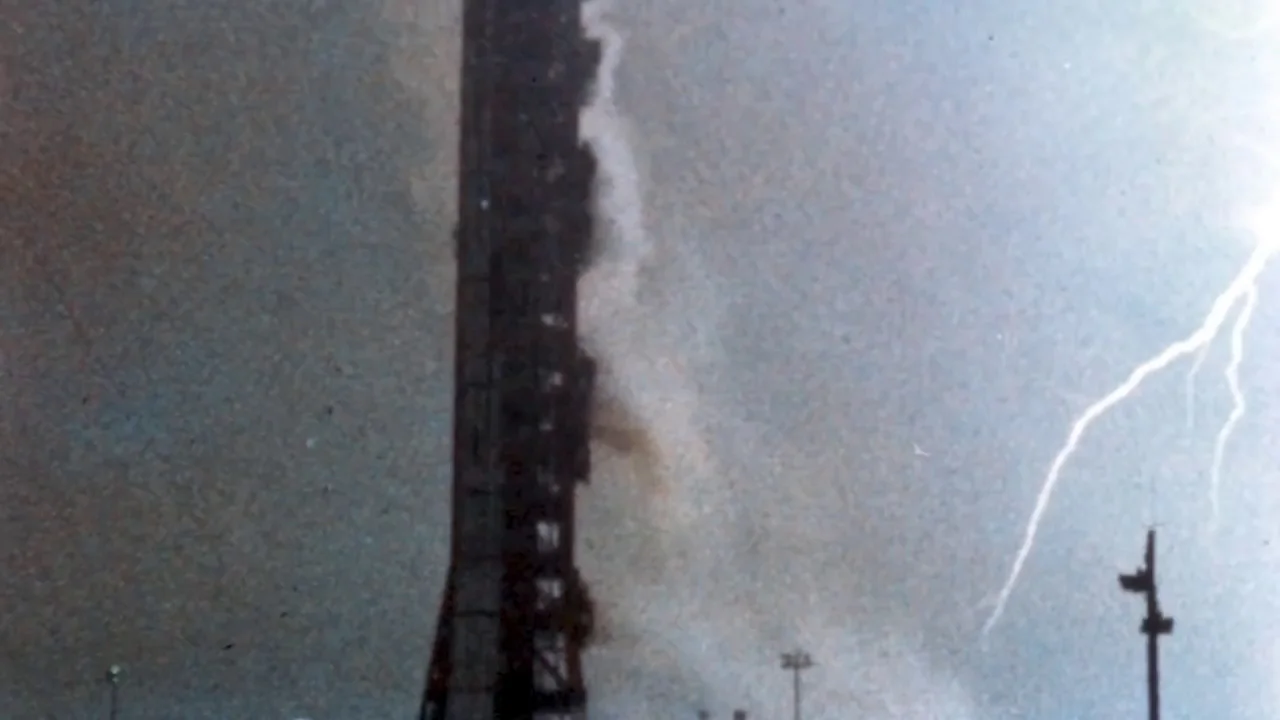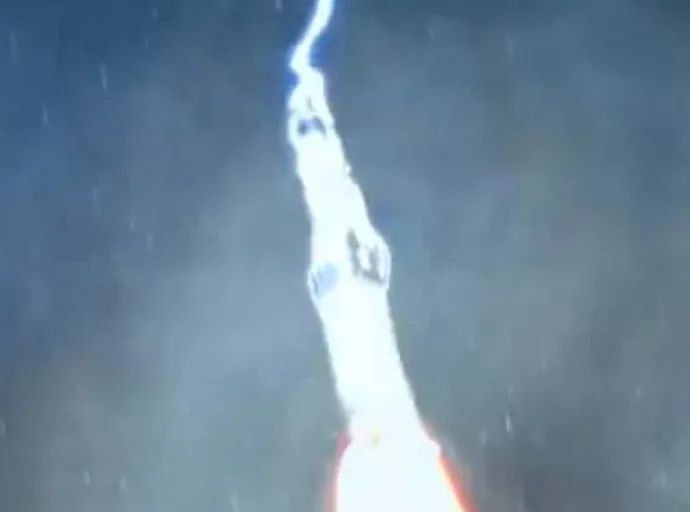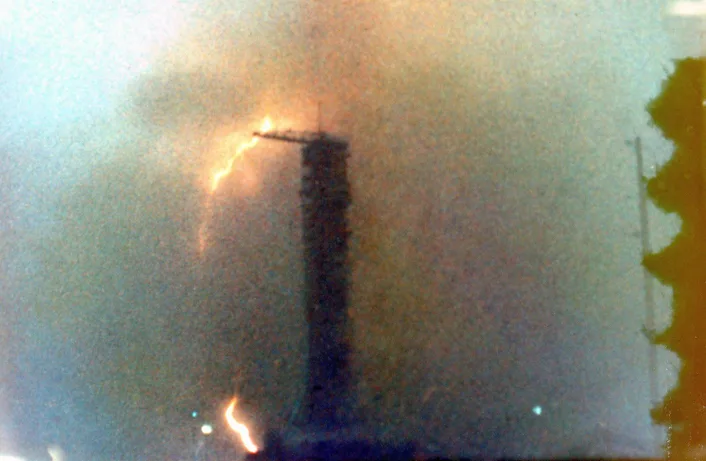
Lightning strikes almost doomed the 1969 Apollo 12 Moon mission
Fifty years ago, two bolts of lightning struck Apollo 12 seconds after launch, but quick thinking saved the mission from failure
Fifty years ago today, on November 14, 1969, Apollo 12 blasted off from Cape Canaveral, carrying NASA astronauts Charles "Pete" Conrad, Alan Bean and Richard "Dick" Gordon on the second human mission to the Moon.
Just 36 seconds after liftoff, a bolt of lightning lanced out from the grey clouds over the launch site, striking the rocket as it climbed towards space.
While the Saturn V booster itself was largely unaffected by the strike, and continued to carry the crew and their spacecraft towards orbit, the intense discharge of electricity had a dramatic impact on the electronics of Apollo 12 spacecraft perched atop the rocket.

This launch photo shows lightning striking the Saturn V rocket booster. Credit: NASA
According to NASA historic files, the lightning discharge knocked out several systems on the Apollo 12 command module. Its fuel cells disconnected from the Saturn V's power, a number of external sensors were lost and power failed to the system that interprets and reports the spacecraft's sensor data to the crew and Mission Control (known as the Signal Conditioning Electronics (SCE) unit).
Without the SCE unit operating, data from the spacecraft's still operating sensors were not being properly reported to Mission Control, which prevented them from being able to tell what was going on, and thus fix the problem.

Flames were spotted on the launch tower after the lightning strike arched from the launch vehicle to the tower. Credit: NASA
"What the hell was that?" Gordon remarked just a half second after the lightning flash. When Conrad inquired, he replied "I lost a whole bunch of stuff; I don't know..."
Conrad reported in to Mission Control "We had a whole bunch of buses drop out," and the crew struggled to figure out what happened.
Before anything could be done, at 54 seconds after launch a second strike flashed out, catching the rocket again, and knocking out the Command Module's guidance system.
"Okay, we just lost the platform, gang," Conrad reported in. "I don't know what happened here; we had everything in the world drop out."
Fortunately, the Saturn V weathered this second strike and continued accelerating towards orbit. From the point of view of the crew, and the engineeers in Mission Control, though, they had no way of knowing this or knowing exactly where the rocket was headed.
During the mission debriefing, after they returned from the Moon, Conrad had reported "at 36 seconds, I first noticed that something had happened outside the spacecraft. I was aware of a white light. I knew that we were in the clouds; and, although I was watching the gauges, I was aware of a white light. The next thing I noted was that I heard the Master Alarm ringing in my ears and I glanced over to the caution and warning panel and it was a sight to behold."
"We got all the lights," Bean added duing the debriefing. "I didn't have an idea in the world what happened. My first thought was that we might have aborted, but I didn't feel any g's, so I didn't think that was what had happened. My second thought was that somehow the electrical connection between the Command Module and the Service Module had separated, because all three fuel cells had plopped off and everything else had gone. I immediately started working the problem from the low end of the pole. I looked at both AC buses and they looked okay, so that was a little confusing."
With the rocket nearly 3 kilometres above the Atlantic Ocean, still blasting towards space, there was very limited time to figure out what the problem was and act on it.
As luck would have it, the flight controller on launch day was John Aaron. During some launch testing before the 14th, he had just helped the Mission Control team work out a very similar problem, so he knew exactly what to do.
He passed on the instructions for the crew to switch the Signal Conditioning Electronics unit over to its auxiliary power, which immediately allowed the crew and Mission Control to get good data on exactly what the spacecraft's systems were reporting. From there, it was a simple matter to review all of the system updates, tell the crew to reset the fuel cells and get the spacecraft's systems working properly again.
Had Aaron not been on the team that day, it is quite possible that Apollo 12 would have reached orbit as a dead spacecraft, left to drift around Earth, unpowered, until Mission Control figured out a way to bring the crew safely back down.
WEATHER IS CRITICAL
Apollo 12 is another excellent example of why weather forecasting is so crucially important to the space program.
Although the weather forecast for Cape Canaveral, even eight hours before the launch, did not indicate a strong chance of storms and lightning, it did show that a weather front had stalled over the area.
That would become a very important point, as onshore winds would run up against that front, producing tall stormclouds as the humid air was forced to rise.
Just three hours before launch, a NASA Public Affairs Officer reported "we appear to have a pretty good rainstorm going on in the vicinity of the launch pad at this time. However it is not interfering with any of our operations in the count. The weather forecast is still Go for launch as far as our 11:22 am Eastern Standard Time T-zero is concerned."
Even if the storms had moved on from the launch site, they should have still been a concern. With the rocket climbing high and angling off to the east after launch, it was flying straight through those clouds, as reported by Conrad during their debriefing.
Rockets can generate significant static charge as they fly through the air, and even if the storm was unlikely to set off a lightning bolt on its own, the Saturn V and its exhaust plume provided the cloud with a shortcut for any built up charge to follow.
These days, launch controllers pay close attention to weather forecasts, looking for thunderstorms or strong winds in the area, any precipitation along the flight path of the rocket, and either exceptionally cold or exceptionally hot temperatures prior to the launch time.
For example, any SpaceX launch can be scrubbed or delayed by the presence of lightning or thunderstorm anvil clouds within a 20 kilometre radius of the launch site. They will also not launch if a cloud within 10 kilometres of the launch site extends high enough into the air to reach freezing temperatures, as these are prime conditions for building up charge for a lightning strike.
Sources: NASA | NASA History











